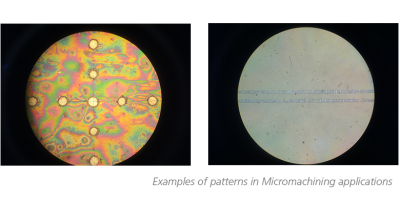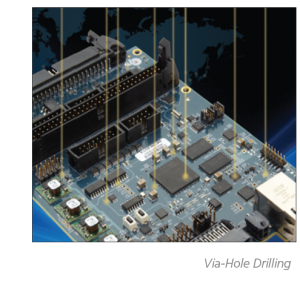マイクロマシニング(および成長市場)の概要
Ever wondered how small 1-500 µm is? To give you a better idea, the average width of a single human hair ranges from 10-200 µm. That’s a VERY small diameter. Now imagine a laser process technology that can make tiny features that width. This process is known as micromachining. Micromachining is an advanced technology that makes micro features in components with dimensions of 1–500 µm using micro fabrication processes. This blog post will talk about the basics of micromachining. We will also look into how this market is sparking growth.
How it Works
In laser processing, building a system that encompasses a laser and laser scanning solution fit to deliver high-precision and stability for micro-sized jobs is critical. One of the most common challenges in this application is the complexity that comes with working with systems this size. That’s why precision and ultra-fine levels of accuracy are so important to system integrators.
Micromachining uses different types of processes such as drilling. This process refers to drilling a hole as small as 10 µm on any material achieving smooth edges regardless of the target material. Another process is laser machining and micro milling. Both refer to the process of removing materials to a specific depth. Both also create features such as grooves, slots and profiles— all done without cutting through the material.

Types of Lasers Used
In micromachining, manufacturers commonly use pulsed lasers because they deposit precise amounts of energy into a material, resulting in accurate material removal that can replicate throughout a job. It is this energy deposition that enables the laser to ablate, cut, drill, machine or scribe a material.
Typical Material Types
We talked about the different processes and type of laser used in micromachining, now let’s focus on the type of materials. Typical materials are polymers, glass, ceramics, metals, silicon, solar cell wafer, diamond, and semiconductor wafer. Depending on the application and laser, there are various fabrication processes available and they differ in throughput, accuracy and performance. Some examples are:
- ビア・ホール・掘削-薄い材質へのレーザー・ホール掘削。
- フレックスPCBドリルおよびトレパニング-掘削および回路上の材質をパネルから除去します。
- セラミック掘削および形状切断 - アルミナまたは他のセラミック材質を使用して、任意の形状での切断もしくは掘削または非線形切断をします。
- 導電性フィルム・パターニング-ガラス、プラスチック、セラミック、フィルムなどのさまざまな材料のパターンフラット・パネルおよびタッチ・スクリーン・ディスプレイ処理用。
- 太陽電池の製造 - PERC、SE、掘削、エッジ分離、スコアリング

Key Application Challenges Micromachining Solves
Micromachining and –an even smaller field– nanotechnology are key players in solving specific application challenges in manufacturing micro and compact components. These may range from biomedical applications to chemical microreactors and sensors. These two technologies are used in microelectromechanical systems (MEMS). This type of technology allows mechanical structures to be miniaturized and integrated in an electrical structure, forming a single system.
As the market demand for smaller devices is on the rise, product miniaturization has become an increasing trend. Thanks to continued technology advances in this field, mass production of micro-sized components designed for micro-and-nano systems has been possible.
The mass production of silicon through micromachining can produce structures inside a substrate, while surface micromachining can make structural thin films on a sacrificial layer for the semiconducting industry.
Market Growth
Increasing market demands in the miniaturization of products and systems have sparked growth in this niche market, forecasting a strong wave of growth for micromachining. Optech Consulting's report projected an expected increase of 10% and 7% in the Compound Annual Growth Rate (CAGR) for micro processing from 2017 to 2020 and 2020 to 2025, respectively. In 2015 the global market revenue for low power sources for material processing reached $2.9 billion, with micro processing contributing a whopping 51% of that total. These are all strong indicators of micromachining’s progression in years to come.
Whether you are interested in miniaturization and how that effects MEMS or simply curious to learn more about micromachining, one thing is for sure, there is a clear potential for growth in this market. Thanks to micromachining’s advanced technology, manufacturing micro-small systems has helped companies adapt its emerging landscape and drive innovation as well as performance even in the smallest spaces.


